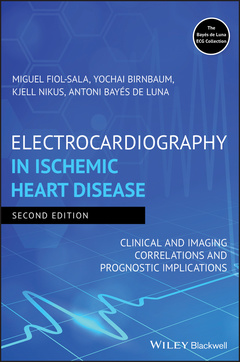Description
Electrocardiography in Ischemic Heart Disease (2nd Ed.)
Clinical and Imaging Correlations and Prognostic Implications
Authors: Fiol-Sala Miquel, Birnbaum Yochai, Nikus Kjell, Bayés de Luna Antoni
Language: English
Subject for Electrocardiography in Ischemic Heart Disease:
181.24 €
In Print (Delivery period: 14 days).
Add to cart432 p. · 17.8x25.4 cm · Hardback
Description
/li>Contents
/li>Biography
/li>
A fresh assessment of ischemic electrocardiography, its prognostic correlations, and the concepts and principles that underlie its use
The electrocardiogram (ECG) is integral to the accurate diagnosis and optimal management of patients with ischemic heart disease. Picking up a wide range of indicators, it provides valuable prognostic data to cardiologists and emergency medicine specialists for whom ECG readings are a trusted and everyday resource. Electrocardiography in Ischemic Heart Disease is designed to help enhance such clinicians' understanding of ECG recordings and their relationship to anatomical patterns of myocardial ischemia, thereby facilitating the continued improvement of patient care.
For this new edition, the book's globally recognized team of authors has revised and expanded the original text to bring it up to date with the cardiology of today. Practical explanations of electrophysiological mechanisms, ischemic insults, and arterial occlusions are placed in the context of the ECG's day-to-day use, while full-color images illustrate core concepts in a vivid and instructive manner. This essential guide:
- Demonstrates correlations between ECG recordings and anatomical patterns of myocardial ischemia
- Covers STEMI, special forms of NSTEMI, and Q waves
- Describes electrocardiographic patterns of ischemia, injury, and infarction
- Includes full-color images
- Explores advanced techniques such as contrast-enhanced cardiac magnetic resonance
Electrocardiography in Ischemic Heart Disease is an indispensable resource for both trainee and practicing cardiologists, emergency medicine physicians, and any clinicians involved in the diagnosis and management of ischemic heart disease.
Foreword to the Second Edition vii
Foreword to the First Edition ix
Introduction xi
Part I The ECG Changes Secondary to Ischemic Heart Disease: Electrophysiologic Bases 1
1 Anatomy of the Heart: The Importance of Imaging Techniques Correlations 3
2 Electrophysiological Bases of Ischemic Heart Disease 27
3 T Wave Changes 41
4 ST‐segment Changes 69
5 QRS and Other Waves Changes 81
Part II The ECG in Different Clinical Settings of Ischemic Heart Disease: Correlations and Prognostic Implications 95
6 The Role of the ECG in Patients with Acute Chest Pain 97
7 Acute Coronary Syndrome with ST Elevation (STE‐ACS) 111
8 ST‐Segment Elevation: Differentiating ST‐Elevation Myocardial Infarction from Non‐Ischemic ST Elevation 181
9 Acute Coronary Syndrome without ST‐Segment Elevation 207
10 Common Mistakes in the Diagnosis of Acute Coronary Syndromes 231
11 ECG in Complications of Acute Coronary Syndromes 249
12 Myocardial Infarction with and without Q Wave or Equivalent 277
13 Silent Ischemia 345
14 The ECG as a Predictor of Ischemic Heart Disease 353
15 Telemedicine in the Diagnosis of Ischemic Heart Disease Through the Surface Electrocardiogram 355
References 369
Index 401
Color plate section can be found facing page 180
Miguel Fiol???Sala, MD, PhD is Scientific Director of the Balearic Islands, Institute of Health Research at the Hospital Son Espases, Palma, Balearic Islands, Spain.
Yochai Birnbaum, MD, FACC, FAHA is Professor of Medicine-Cardiology and John S. Dunn Chair in Cardiology Research and Education at the Baylor College of Medicine, Houston, TX, USA.
Kjell Nikus, MD, PhD is Professor of Cardiology, Faculty of Medicine and Health Technology, Tampere University and Head of Department, Heart Center, Tampere University Hospital, Tampere, Finland.
Antoni Bayés de Luna, MD, FESC, FACC is Director of Cardiology at Hospital Quirón and Emeritus Professor of Cardiology at Universitat Autònoma de Barcelona, Barcelona, Spain.




